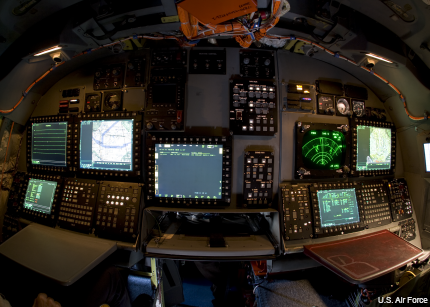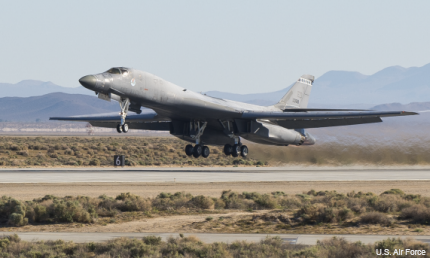Software upgrades boost B-1B bomber’s effectiveness, longevity
The Air Force is testing new software intended to integrate the Lancer’s new features and improve situational awareness.

The interior of the B-1B Lancer displays its improved communications.
The Air Force is testing software upgrades that will help improve the supersonic B-1B Lancer’s longevity and functionality in an integrated battlespace.
The 419th Flight Test Squadron at Edwards Air Force Base, Calif., began testing what’s called Sustainment Block 16A software at the beginning of April, looking to enhance the performance of the bomber’s recently introduced glass cockpit and improve situational awareness, the Air Force said. The upgrade includes improvements to Link 16 data link capabilities, which allow any entity equipped with Link 16—whether other aircraft or naval or ground forces—to exchange tactical information and images in near-real time.
"The SB 16A configuration is expected to improve situational awareness to all crew members, increase the maintainability of the B-1B and provide data link capabilities to the field," said Capt. Carlos Pinedo, 419 FLTS B-1 test pilot and flight commander. The upgrade will improve integration of the bomber’s offensive integration system with onboard sensors and the Link 16 data link.
"The overall result is improved situational awareness and a reduction in crew workload, leading to improved combat effectiveness,” Pinedo said. “The improved sustainability of the B-1B as a result of this program will help maintain the Air Force's long-range strike capability for many years to come."
The B-1B, made by Rockwell International (whose aerospace and defense units were later acquired by Boeing), was introduced in 1986, initially as a nuclear bomber. It was converted for conventional bombing in the early 1990s after the first Gulf War. And although some have called for the B-1 fleet to be retired, the Air Force expects that it will stay in service into the 2030s.

A Lancer takes off April 1 from Edwards to begin software tests.
But keeping them in the air that long in an era of greater integration and joint operations with other services requires some improvements. In January, the Boeing Integrated Battle Station was added \, with major upgrades to the front and aft cockpits, a new diagnostics system, and the new Link 16 data link, Avionics Intelligence reported at the time.
The upgrades, the most significant since the first Lancers went into service, included replacing monochrome displays with full-color screens, new monitoring and test systems and digital flight instrumentation.
Now, the Air Force is testing the SB 16A software package to ensure the new features all work together. The tests are expected to be completed by February 2015.



